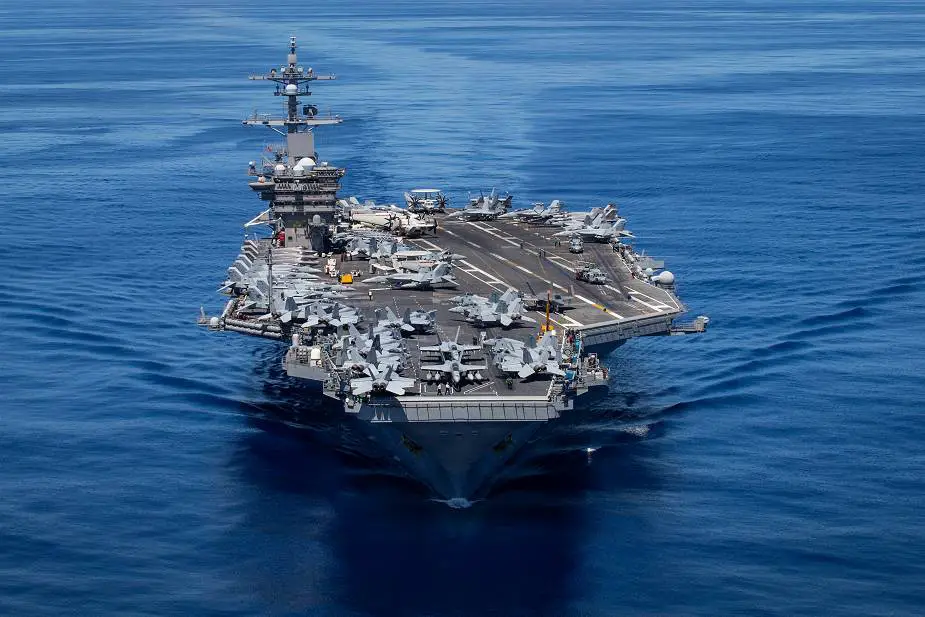Breaking news
First operational deployment for US Navy aircraft carrier USS Carl Vinson with F-35C and CMV-22B.
According to information published by the U.S. Navy on June 18, 2021, U.S. Navy units assigned to Carrier Strike Group (CSG) 1 with U.S. Navy aircraft carrier USS Carl Vinson (CVN 70) are operating in the Hawaiian Islands Operating Area. The ship operates for the first time F-35C Lightning II fighter and CMV-22B Osprey tiltrotor aircraft after 17-month maintenance availability allowing the ship to support 5th generation aircraft.
Follow Navy Recognition on Google News at this link
 In August 2020, Vinson completed a 17-month maintenance availability to receive major upgrades in order to support 5th generation aircraft, making Vinson the first aircraft carrier equipped to support both the F-35C Lightning II and CMV-22B Osprey. (Picture source U.S. Navy)
In August 2020, Vinson completed a 17-month maintenance availability to receive major upgrades in order to support 5th generation aircraft, making Vinson the first aircraft carrier equipped to support both the F-35C Lightning II and CMV-22B Osprey. (Picture source U.S. Navy)
The aircraft carrier USS Carl Vinson (CVN 70), the flagship of CSG-1, operates alongside Carrier Air Wing (CVW) 2, Destroyer Squadron 1, the guided-missile destroyers USS O’Kane (DDG 77), USS Howard (DDG 83), USS Chafee (DDG 90), USS Dewey (DDG 105) and USS Michael Murphy (DDG 112).
High level, joint and combined training among U.S. Navy forces ensures the U.S. military remains the preeminent military power in the region, capable of honoring its security commitments to allies, partners, and friends. Subsequently, Vinson will be conducting Combat Efficiency Operations to include integrated flight operations between CVW-2’s carrier-based aircraft and land-based Marine Corps and Air Force fighter squadrons, as well as U.S. Coast Guard C-130s.
In August 2020, Vinson completed a 17-month maintenance availability to receive major upgrades in order to support 5th generation aircraft, making Vinson the first aircraft carrier equipped to support both the F-35C Lightning II and CMV-22B Osprey. Upgrades include enhanced jet blast deflectors able to take the increased heat generated by the F-35C and the addition of the Autonomic Logistics Information System, which is the new computer network that supports the unique maintenance and tactical operations functions of the advanced aircraft.
With its recent modifications, no other weapons platform has the responsiveness, endurance, multi-dimensional capacity, inherent battlespace awareness or command and control capabilities of CSG-1.
Other components of the air wing include three U.S. Navy Strike Fighter Squadrons that fly the F/A-18 Super Hornet, one Electronic Attack Squadron that operates the EA-18G Growler, one Airborne Command & Control Squadron that operates the E-2D Hawkeye, one Helicopter Maritime Strike Squadron, and one Helicopter Sea Combat Squadron. Through multiplatform integration, CVW-2 will provide fleet commanders the ability to achieve the advantage across multiple domains.
In addition to joint flight operations, U.S. Navy guided-missile destroyers are conducting joint operations with U.S. Coast Guard cutters USCGC Midgett (WMSL 757) and USCGC Oliver Berry (WPC 1124) expanding interoperability between AEGIS weapons systems and unmanned systems.
As an integral part of the U.S. Pacific Fleet, U.S. 3rd Fleet operates naval forces in the Indo-Pacific in addition to providing realistic and relevant training necessary to flawlessly execute our Navy's timeless roles of sea control and power projection. U.S. 3rd Fleet works in close coordination with other numbered Fleets to provide commanders with capable, ready forces to deploy forward and win in the day-to-day competition, in crisis, and in conflict.


























